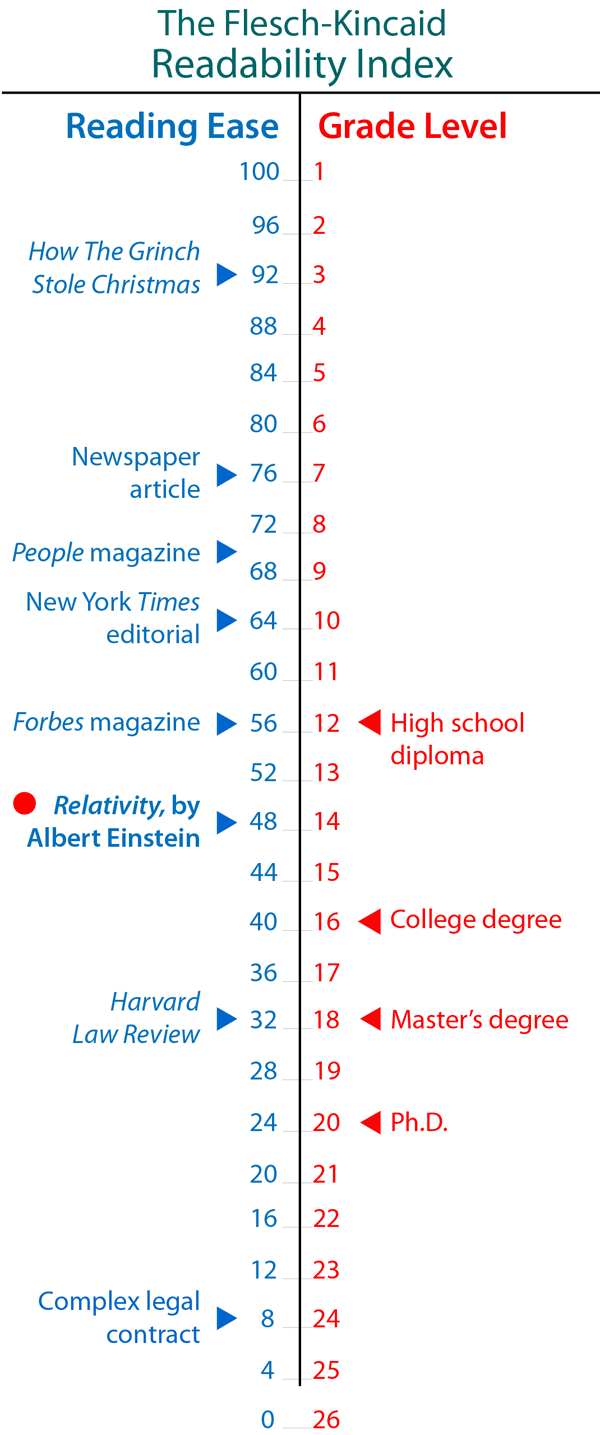


|
|||
|
Albert Einstein's RELATIVITY is far more readable than most corporate sites today. Part of Einstein's duties in his day job at the Swiss patent office was to take incoming patent applications and write an assessment of them that would be understandable to the higher-ups, because the decision-makers were often bureaucrats and political appointees without a technical education. Einstein intentionally wrote RELATIVITY in a way that made it understandable to anybody with a high school education. In the Preface he said, "The present book is intended to give an exact insight into the theory of Relativity to those readers who are interested in the theory, but who are not conversant with the mathematical apparatus of theoretical physics." Readability has nothing to do with the complexity or seriousness of the subject. It's not a matter of "dumbing down" the text. It's about clarity, precision, and plain, straightforward language that's easy to understand. Technical and industrial companies often present themselves in corporate literature that scores very low on the readability scale. They write their marketing text at an excruciating level of difficulty because they think it makes them seem lofty and important. They bury their corporate message under a barrage of abstract and passive language. Recently a client told me their message wasn't getting across; I pasted the text from their Web site into the Flesch-Kincaid Readability Index and it came out 26th grade: you needed three PhD's to comprehend their text. That is a very limited demographic. How hard to read is your company's marketing text? |
Previous posts: The technology of text Is your brochure easier to read than Einstein's "Relativity?" They expected me to copywrite ads for free. Is copywriting dead, or is it just me? 10 ways to make a visitor read the text on your web site. Clear, simple text for your company's site.
|
||
How readability is measured. In 1951, Rudolf Flesch devised the Reading Ease formula which is based on the length of the sentences and the number of syllables per word. "Not everything can be simplified to the level of a tabloid newspaper. Most people would expect theoretical physics to be right at the bottom of any list when it comes to readability – yet, scientists such as Albert Einstein and Stephen Hawking managed to communicate complex subjects, such as quantum mechanics or black hole explosions, in surprisingly clear language, typically achieving Flesch reading ease scores in the low to mid-40s." |
 |
||
Most corporate brochures are lucky to break into the 30s on the Reading Ease scale. Thick, turgid stuff down into the teens is not uncommon. The corporate message is buried under a barrage of abstract and passive language. If people don't read it, it might as well not be there. If you're going to publish text about your company, you might as well make it readable. Otherwise, what's the point? I've been writing brochures for technical and industrial companies for thirty years. I know enough about science and engineering to have an idea of what the technology people are trying to say. I can reassemble their words into a coherent flowing structure. I take apart the verbiage and re-cast it in active and concrete terms that people can understand and remember. |
|||